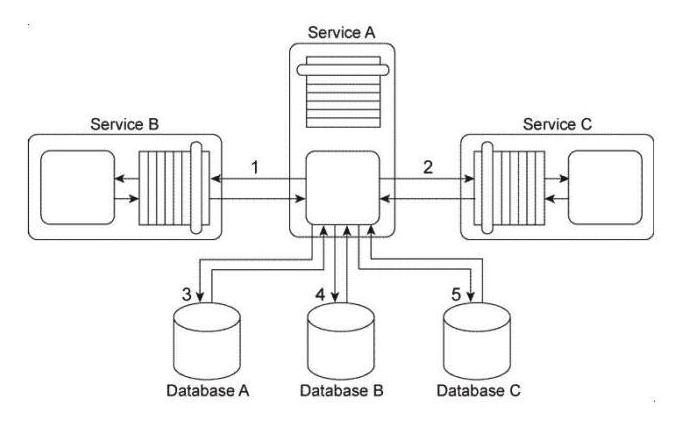Service A is an entity service that provides a set of generic and reusable service capabilities. In order to carry out the functionality of any one of its service capabilities, Service A is required to compose Service B (1) and Service C (2) and Service A is required to access Database A (3) , Database B (4) , and Database C (5) . These three databases are shared by other applications within the IT enterprise. All of service capabilities provided by Service A are synchronous, which means that for each request a service consumer makes. Service A is required to issue a response message after all of the processing has completed. Depending on the nature of the service consumer request, Service A may be required to hold data it receives in memory until its underlying processing completes. This includes data it may receive from either Service A or Service B or from any of the three shared databases. Service A is one of many entity services that reside in a highly normalized service inventory. Because Service A provides agnostic logic, it is heavily reused and is currently part of many service compositions.  You are told that Service A has recently become unstable and unreliable. The problem has been traced to two issues with the current service architecture. First, Service B, which is also an entity service, is being increasingly reused and has itself become unstable and unreliable. When Service B fails, the failure is carried over to Service A . Secondly, shared Database B has a complex data model. Some of the queries issued by Service A to shared Database B can take a very long time to complete. What steps can be taken to solve these problems without compromising the normalization of the service inventory?
You are told that Service A has recently become unstable and unreliable. The problem has been traced to two issues with the current service architecture. First, Service B, which is also an entity service, is being increasingly reused and has itself become unstable and unreliable. When Service B fails, the failure is carried over to Service A . Secondly, shared Database B has a complex data model. Some of the queries issued by Service A to shared Database B can take a very long time to complete. What steps can be taken to solve these problems without compromising the normalization of the service inventory?
A) The Redundant Implementation pattern can be applied to Service A, thereby making duplicate deployments of the service available. This way, when one implementation of Service A is too busy, another implementation can be accessed by service consumers instead. The Service Data Replication pattern can be applied to establish a dedicated database that contains an exact copy of the data from shared Database B that is required by Service A .
B) The Redundant Implementation pattern can be applied to Service B, thereby making duplicate deployments of the service available. This way, when one implementation of Service B is too busy, another implementation can be accessed by Service A instead. The Service Data Replication pattern can be applied to establish a dedicated database that contains an exact copy of the data from shared Database B that is required by Service A .
C) The Redundant Implementation pattern can be applied to Service B, thereby making duplicate deployments of the service available. This way, when one implementation of Service B is too busy, another implementation can be accessed by Service A instead. The Service Data Replication pattern can be applied to establish a dedicated database that contains a copy of the data from shared Database B that is required by Service A . The replicated database is designed with an optimized data model in order to improve query execution performance.
D) None of the above.
Correct Answer:
Verified
Q11: Service A is a utility service that
Q12: Service A is a task service that
Q13: When Service A receives a message from
Q14: Service A is a utility service that
Q15: Service A is a task service that
Q17: Services A, B, and C are non-agnostic
Q18: Service A is a task service that
Q19: Service Consumer A sends a message to
Q20: Service Consumer A sends a message to
Q21: Service Consumer A sends a message with
Unlock this Answer For Free Now!
View this answer and more for free by performing one of the following actions

Scan the QR code to install the App and get 2 free unlocks

Unlock quizzes for free by uploading documents